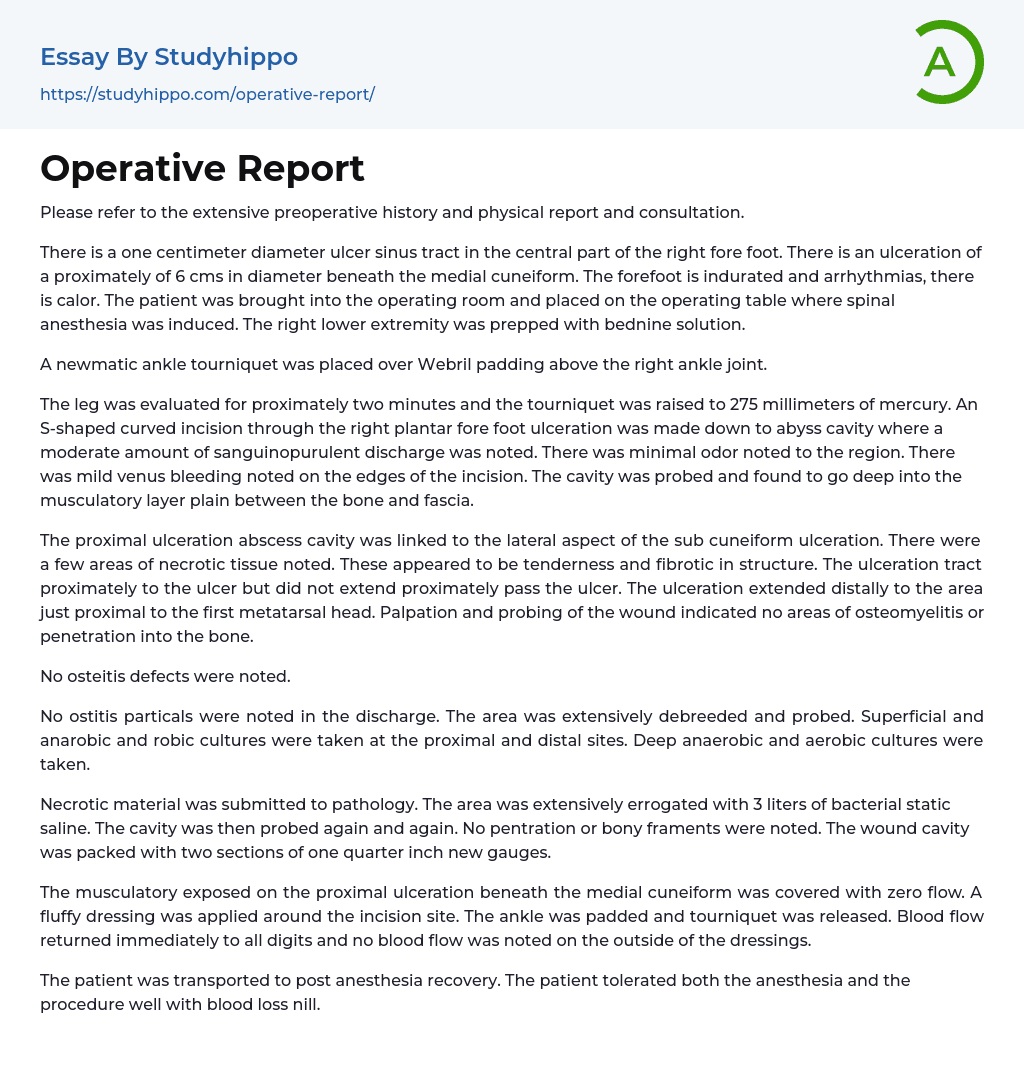Please see the comprehensive preoperative history, physical report, and consultation. In the central area of the right forefoot, there is a one-centimeter ulcer sinus tract. Beneath the medial cuneiform, there is an ulceration of around 6 cm in diameter. The forefoot is indurated and arrhythmias, with a sensation of warmth. The surgical team administered spinal anesthesia to the patient and placed the right lower extremity on the operating table. Bednine solution was used to prepare the right lower extremity. Next, they put a pneumatic ankle tourniquet over Webril padding on top of the right ankle joint. After a two-minute evaluation, the tourniquet was lifted to 275 millimeters of mercury. An S-shaped incision was made through the ulceration in the right plantar forefoot, down to an abyss cavity where they found some sanguinopurulent discharge and minimal odor. There
...was minor venous bleeding on the incision edges, and upon probing, they discovered that the cavity went deep into the muscle layer plain between the bone and fascia. They connected the proximal ulceration abscess cavity to the lateral aspect of the sub-cuneiform ulceration and noticed some necrotic tissue, which had a tender and fibrotic structure. The ulceration tract was adjacent to but did not exceed past the ulcer.The ulceration had extended to the area proximal to the first metatarsal head, but palpation and probing revealed no osteomyelitis or bone penetration. No osteitis particles were found in the discharge, and the area was extensively cleaned and probed. Cultures were taken at both proximal and distal sites, including deep anaerobic and aerobic cultures. Necrotic material was sent to pathology. The wound cavity was thoroughly irrigated and no penetration or bon
fragments were detected. The cavity was packed with two sections of one quarter inch new gauges. The musculature exposed on the proximal ulceration beneath the medial cuneiform was covered with zero flow, and a fluffy dressing was applied around the incision site. After releasing the tourniquet, blood flow immediately returned to all digits. The patient experienced minimal blood loss and tolerated both anesthesia and the procedure well.
- Pregnancy essays
- Death essays
- Asthma essays
- Chronic Pain essays
- Diabetes essays
- Infection essays
- Infertility essays
- Pain essays
- Sexually Transmitted Disease essays
- Cholesterol essays
- Epidemic essays
- Pathogen essays
- Symptom essays
- Water supply essays
- Myocardial Infarction essays
- Chronic essays
- Hypertension essays
- Black Death essays
- Breast Cancer essays
- Down Syndrome essays
- Apoptosis essays
- Tuskegee Syphilis Experiment essays
- Type 2 Diabetes essays
- Addiction essays
- Anatomy and Physiology essays
- Biodegradation essays
- Cancer essays
- Dental Care essays
- Disability essays
- Disease essays
- Disorders essays
- Health Care essays
- Infectious Disease essays
- Inquiry essays
- Intelligence Quotient essays
- Lung Cancer essays
- Medicine essays
- Neurology essays
- Nutrition essays
- Olfaction essays
- Physical Exercise essays
- Public Health essays
- Sex essays
- Women's Health essays
- World health organization essays
- alternative medicine essays
- Aspirin essays
- Cannabis essays
- Cardiology essays
- Cloning essays




